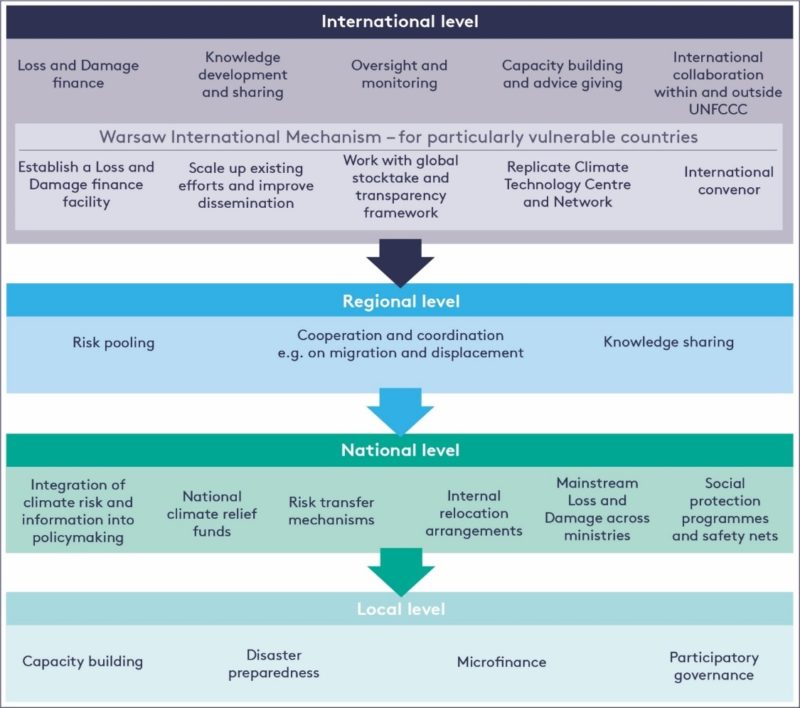CLIMATE CHANGE LOSS& DAMAGE
1. Introduction:
- Loss & damage refer to the negative consequences of climate change on human societies & the natural environment.
- Climate change is affecting the geographical distribution of extreme weather events like storms, floods, and heatwaves & slow-onset events like sea level rise, ocean acidification, loss of biodiversity, and desertification.
- All of these result in loss & damage, both economic & non-economic including damage to crops, homes, and infrastructure; harm to human health, and mobility, loss of access to territory, damage to biodiversity & habitats.
2. Causes:
- The impacts of extreme weather events arise through a combination of anthropogenic climate change & natural climate variability.
- The scientific consensus is that human-caused climate change increases the frequency and severity of climate-related events & effects of natural climate variability like El Nino-southern oscillations (ENSO) cycles.
- These factors are leading to more destructive climate impacts & higher risks of loss & damage.
- Attributing specific losses & damage to human-caused climate change is a challenge, though attribution science is a fast-growing research field.
3. Extent of Loss & Damage:
- Some loss & damage from climate change are unavoidable for two reasons.
- Firstly, some climate change impacts are inevitable as they are locked into the earth's system due to the extended period over which emitted Green House Gases fully affect the climate system.
- Secondly, there are limits to how far we can adapt to climate change impacts.
- Loss & damage may occur where adaptation was optimally implemented or adaptation limits are reached.
- As actions are unaffordable, not physically/technically possible, and socially difficult to prevent harm to humans, the environment & assets.
- The financial cost of damage caused by extreme weather events linked to climate change is better explained by the extreme flooding in Pakistan in 2022.
- It was estimated that the losses cost up to 40 billion dollars.
- Climate change exacerbated the flooding by increasing the intensity of rainfall by an estimated 50-70%.
- The floods affected 33 million people, cost 1600 lives, destroyed over 2 million houses, and damaged 13,000km of roads, and 18,000 square km of croplands.
| Depending on the extent of global efforts to mitigate & adapt to climate change, loss & damage from climate change that goes beyond adaptation could cost developing countries a total of US$ 290-580 billion in 2030 & may reach US$1-1.8 trillion in 2050. |
4. International Climate Negotiations:
- The loss & damage debate was contentious within the international climate negotiations because of fairness, equity & proving historical responsibility for climate change.
- Developing countries claim that developed countries have a historical responsibility for climate change.
- Developed countries have called for compensation from developed countries to help them address loss & damage that have already occurred & to minimise future loss & damage.
- Calls to pay compensation were a major red line for these wealthy nations, which consider addressing loss & damage as ex-ante adaptation, namely advance measures to minimise loss & damage.
- In focusing on minimising future harm, developed countries have sought to treat loss & damage as a sub-component of adaptation within the UNFCCC negotiations.
- This is addressed through the Warsaw International Mechanism for loss & damage, established at the COP19 UN climate conference in 2013.
- The role of the mechanism is to address the issue of loss & damage in developing countries by enhancing the knowledge of risk management approaches and strengthening coordination to address losses & damage.
- During the review of the Mechanism in 2019 at COP25, many developing countries called for its role to be strengthened & for it to deliver finance to vulnerable, developing countries to minimise, and address loss & damage.

5. Reducing Loss & Damage:
- To reduce loss & damage from climate change include increasing resilience before the occurrence of extreme weather or slow-onset event.
- For instance, by strengthening flood defences & establishing mechanisms to provide financial/social protection support to those who experienced loss & damage.
- Insurance is one important tool but is not affordable to all.
- By incorporating resilience into recovery like rebuilding infrastructure to be more climate-resilient in future also helps in reducing loss & damage.
- Specific actions to mitigate & adapt to climate change are essential in both developing & developed countries to avert & minimise the extent of loss & damage they experience.
- Broader policy & governance arrangements also play a significant role.
- This is because communities' vulnerability & exposure to climate change is influenced by a multitude of factors like land-use planning, access to education & health services, quality-location of infrastructure, and disaster preparedness which requires a response across different policy areas.
- This involves targeting the most vulnerable communities & developing policies that address the root causes of their vulnerability, to build resilience against future loss & damage.




